Are you looking for the best way to ensure top-notch workplace safety? A fire alarm system can provide peace of mind that potential threats are quickly detected and addressed. Good fire safety design protects a home, business, or any other building from danger.
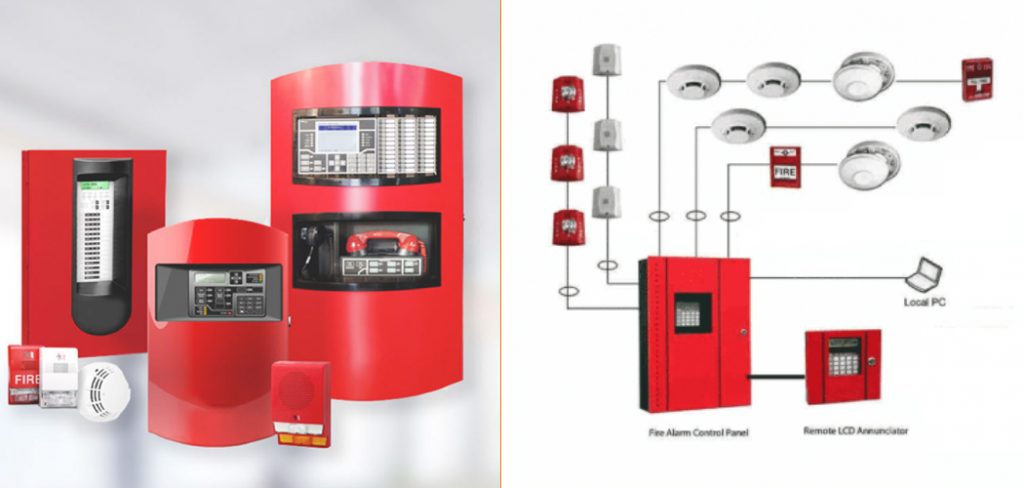
Designing an adequate fire alarm system requires strategic planning and careful consideration, but with the proper guidance, it can be done efficiently and cost-effectively.
Fire alarm systems are vital in alerting occupants of danger and giving them the time to evacuate safely. If you want information on how to design a fire alarm system, this blog post is for you! Here, we will break down the critical elements of effective fire alarm system design so that you can be sure your building remains protected at all times. Read on to learn more!
Necessary Items for Fire Alarm System Design
Before diving into the details of fire alarm system design, let’s first discuss the necessary items for a basic, functional system.
- Fire Alarm Control Panel (FACP): This is the central control unit responsible for receiving and processing signals from other components in the system.
- Smoke Detectors: These devices sense smoke particles in the air and trigger an alarm when levels exceed a certain threshold.
- Heat Detectors: Like smoke detectors, these devices respond to high temperatures instead of smoke particles.
- Manual Pull Stations: These are physical switches that can be manually activated in an emergency.
- Audio/Visual Notification Appliances: These include alarms, strobe lights, and speakers that alert occupants of danger through sound and visual signals.
- Monitoring Service: This service provides 24/7 monitoring of your fire alarm system and can alert emergency services if necessary.
10 Steps on How to Design Fire Alarm System
Now that we know the essential components of a fire alarm system let’s discuss some key considerations when designing one for your building:
Step 1: Building Layout and Occupancy Classification
The first step in designing a fire alarm system is understanding the layout of your building and its occupancy classification. Different types of buildings and spaces have specific code requirements for fire safety, so it’s crucial to consult with local authorities on this matter.
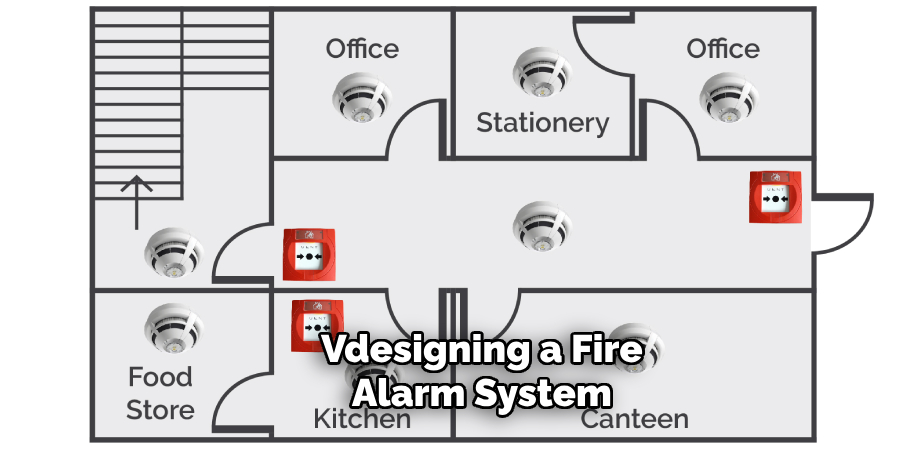
Step 2: Identify Potential Fire Hazards
Conduct a thorough assessment of your building to identify potential fire hazards. These can include anything from electrical equipment to flammable materials and should be addressed in the design of your fire alarm system.
Step 3: Determine Necessary Zones
Divide your building into different zones based on occupancy, layout, and potential hazards. This helps localize potential fires and makes it easier for emergency personnel to respond quickly.
Step 4: Choose Appropriate Detectors
Choose appropriate detectors for each area based on the hazards identified and the zones designated. Smoke detectors are best for detecting fires with visible smoke, while heat detectors are ideal for spaces with high ceilings or frequent false alarms.
Step 5: Develop Alarm Signals and Notification Methods
It’s essential to have a clear and compelling alarm signal in an emergency. Choose a loud, distinct sound for your alarm and consider using visual notification devices for individuals with difficulty hearing.
Step 6: Determine Power Supply
Fire alarm systems require reliable power sources to function correctly. Consider backup power options such as batteries or generators in case of a power outage.
Step 7: Create an Evacuation Plan
An evacuation plan is crucial in ensuring occupants can safely and efficiently evacuate the building in case of a fire. This should be communicated to all individuals within the building and practiced regularly.
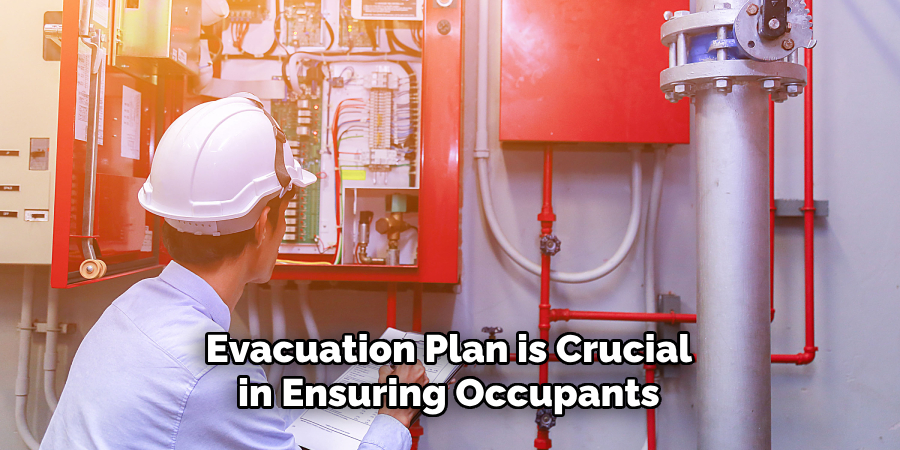
Step 8: Choose a Monitoring Service
Consider using a monitoring service to ensure your fire alarm system is constantly monitored and ready for any emergency. They can provide additional support in case of false alarms or system malfunctions.
Step 9: Follow Code and Regulatory Requirements
Follow all applicable codes and regulations when designing your fire alarm system. This includes regular inspections and maintenance to ensure the system remains in compliance.
Step 10: Test Your System Regularly
Finally, it’s crucial to regularly test your fire alarm system to ensure it functions correctly. This includes testing all components and conducting drills to ensure occupants are familiar with evacuation procedures.
Designing a fire alarm system may seem daunting, but by following these ten steps on how to create a fire alarm system, you can be sure your building is equipped with an effective and reliable system.
Remember to consult with local authorities and experts in the field for additional guidance and support. With proper planning and implementation, you can ensure the safety of your occupants and peace of mind for yourself.
9 Things to Avoid When Designing a Fire Alarm System
While there are essential steps to follow when designing a fire alarm system, it’s also crucial to be aware of common mistakes that can compromise the effectiveness of your system. Here are nine things to avoid:
1. Poor Placement of Detectors
Placing detectors in areas with high airflow, heat sources, or potential obstructions can lead to false alarms or delayed fire detection. Make sure to consider the placement of detectors in each zone carefully.
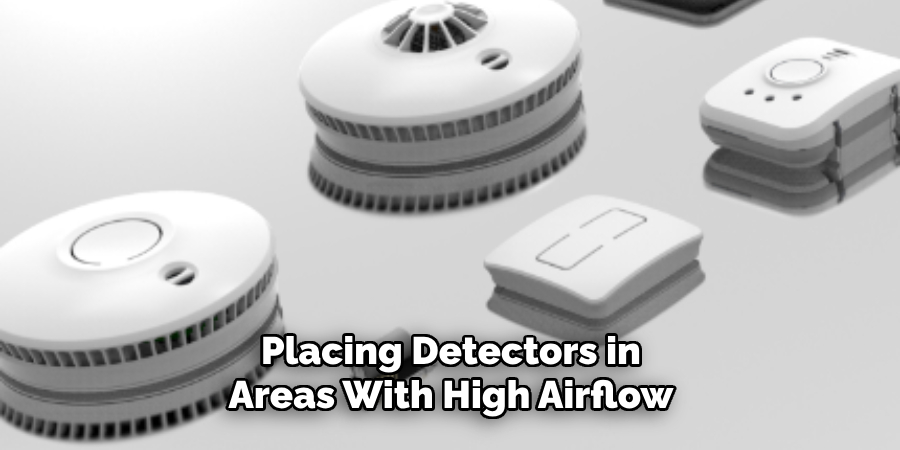
2. Inadequate Coverage
Not having enough detectors or notification devices can leave blind spots and compromise the safety of your building. Make sure to assess the coverage needs for each area.
3. Incorrect Detector Selection
Choosing the correct type of detector for a specific area can result in reliable detection and false alarms. Make sure to select detectors based on the hazards present in each zone.
4. Lack of Redundancy
In case of a primary system malfunction or failure, backup components such as detectors, power sources, and notification devices are essential.
5. Poor Maintenance
Regular inspections and maintenance are crucial to ensure the proper functioning of your fire alarm system. Neglecting these tasks can result in false alarms or failures during an emergency.
6. Not Considering Occupant Needs
An effective fire alarm system should consider the needs of all occupants, including individuals with disabilities or those who may have difficulty hearing or seeing.
7. Ignoring Code and Regulatory Requirements
Failure to comply with local codes and regulations can result in costly fines and compromise the safety of your building and its occupants.
8. Lack of Regular Testing and Drills
Without regular testing and drills, occupants may not be familiar with evacuation procedures, and the effectiveness of your system cannot be ensured. It’s crucial to conduct these activities regularly to maintain a safe environment.

9. Not Seeking Professional Help
Designing a fire alarm system is not a task to be taken lightly, and it’s always best to seek the help of professionals in the field. They can provide valuable insights and ensure your system meets all requirements for safety and compliance.
Designing a fire alarm system requires careful consideration and planning to ensure the safety of occupants and compliance with regulations. By following these steps and avoiding common mistakes, you can create a compelling and reliable system for your building.
Remember to test and maintain your design in optimal condition regularly. So, it’s crucial to stay up-to-date on the latest codes and regulations, seek expert guidance when needed, and always prioritize the safety of your building and its occupants.
9 Safety Measures for Fire Alarm System Maintenance
Maintaining a fire alarm system is crucial to ensure its proper functioning in an emergency. Neglecting maintenance can result in false alarms, system failure, and potential harm to occupants. Here are nine safety measures to consider when maintaining your fire alarm system:
1. Follow Manufacturer’s Instructions
Always follow the manufacturer’s recommended guidelines for maintenance and testing. They know their products best and can provide essential insights on how to keep your system in top condition.
2. Train Personnel Properly
Ensure that all individuals responsible for maintaining or using the fire alarm system are adequately trained, certified, and knowledgeable about the equipment. This will ensure proper handling and reduce the risk of accidents or errors.

3. Use Proper Tools
Avoid using makeshift tools or improper methods when conducting maintenance tasks, as this can damage the system or put individuals at risk. Always use appropriate tools and follow standard procedures.
4. Disconnect Power Before Maintenance
Before beginning any maintenance tasks, disconnect all power sources to the system to avoid potential electrical hazards. Follow proper lock-out/tag-out procedures as necessary.
5. Use Personal Protective Equipment (PPE)
Wearing appropriate PPE can protect maintenance personnel from hazards such as electric shock or exposure to hazardous materials. Be sure to provide and require PPE when performing maintenance tasks.
6. Inspect and Test Regularly
Regular inspections and testing can detect any issues early on and ensure the system functions correctly. Make sure to document all maintenance activities for record-keeping purposes.
7. Keep the System Clean
Dust, debris, or other materials can impede the proper functioning of your fire alarm system. Regularly clean all components to ensure they are free from any obstructions that may compromise their effectiveness.
8. Seek Professional Help When Needed
Some maintenance tasks require the expertise of trained professionals, such as inspecting and maintaining the fire alarm control panel or performing in-depth system testing. Don’t hesitate to seek professional help when necessary.
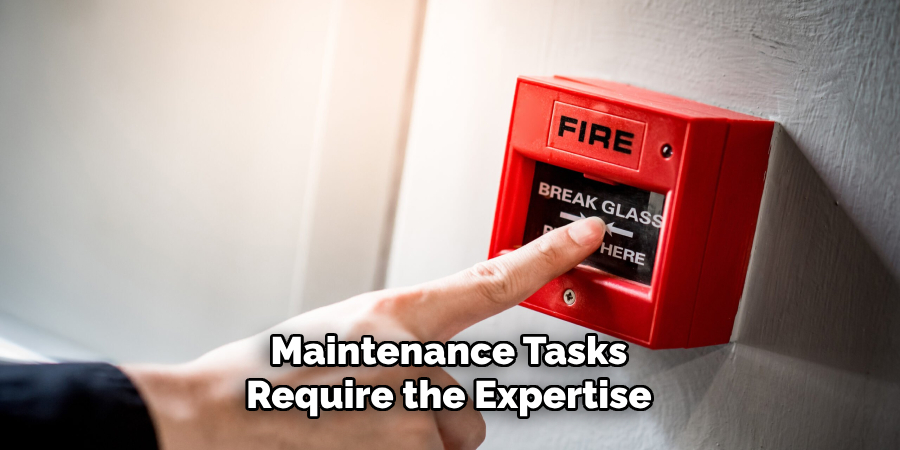
9. Have a Contingency Plan
In case of system failure or unexpected issues during maintenance, make sure to have a contingency plan in place to ensure the safety of occupants and minimize potential damages.
By following these safety measures, you can maintain your fire alarm system in optimal condition and ensure the safety of your building and its occupants. Regular maintenance is critical to a reliable and effective fire alarm system. So, prioritize it for the well-being of all those who reside or work in your building.
Frequently Asked Questions
What Are the Essential Steps to Designing a Fire Alarm System?
The essential steps include identifying hazards, determining necessary zones, choosing appropriate detectors, developing alarm signals and notification methods, selecting a power supply, creating an evacuation plan, choosing a monitoring service, following code and regulatory requirements, and regularly testing the system.
What Should I Avoid When Designing a Fire Alarm System?
Be sure to avoid poor placement of detectors, inadequate coverage, incorrect detector selection, lack of redundancy, poor maintenance, not considering occupant needs, ignoring code and regulatory requirements, and lack of regular testing and drills. These mistakes can compromise the effectiveness of your system and put occupants at risk.
Why Is It Important to Regularly Test and Maintain a Fire Alarm System?
Regular testing and maintenance ensure the proper functioning of your system, reduce false alarms, and familiarize occupants with evacuation procedures. Neglecting these tasks can result in failures during an emergency and compromise the safety of occupants.
So, it’s crucial to conduct regular inspections and tests as experts and local authorities recommend. Additionally, maintain all components of your system according to manufacturer guidelines. This will help ensure the longevity and effectiveness of your fire alarm system.
How Can I Stay Up to Date on Codes and Regulations for Fire Alarm Systems?
Local authorities and fire safety experts are excellent resources for staying informed about codes and regulations in your area. You can also research online or attend industry conferences and workshops to stay updated on the latest developments and requirements. Always comply with all codes and regulations to ensure the safety of your building and its occupants.
With proper maintenance and adherence to safety measures, your fire alarm system can provide crucial protection in an emergency. Make sure to prioritize its regular upkeep and seek expert guidance when needed for optimal performance. Remember, a well-maintained fire alarm system can make all the difference in protecting lives and property.
Conclusion
Designing a fire alarm system is crucial to building safety and requires careful planning and implementation. By following essential steps on how to design fire alarm system and avoiding common mistakes, you can create a compelling and reliable system for your building. Remember to test and maintain your system regularly, stay informed about codes and regulations, and prioritize the safety of your occupants.
With proper care and attention, you can ensure the effectiveness and longevity of your fire alarm system. So, stay informed, seek expert guidance when needed, and always prioritize safety. Your occupants’ lives may depend on it. For more information about designing a fire alarm system or to request a consultation, contact a fire safety expert today.
About
Safety Fic is a distinguished figure in the world of Diy design, with a decade of expertise creating innovative and sustainable Diy solutions. His professional focus lies in merging traditional craftsmanship with modern manufacturing techniques, fostering designs that are both practical and environmentally conscious. As the author of diy, Safety Fic delves into the art and science of Safety Fic-making, inspiring artisans and industry professionals alike.
Education RMIT University
(Melbourne, Australia) Associate Degree in Design (Safety Fic) Focus on sustainable design, industry-driven projects, and practical craftsmanship. Gained hands-on experience with traditional and digital manufacturing tools, such as CAD and CNC software.
Nottingham Trent University
(United Kingdom) Bachelor’s in diyfastly.com and Product Design (Honors) Specialized in product design with a focus on blending creativity with production techniques. Participated in industry projects, working with companies like John Lewis and Vitsoe to gain real-world insights.
Publications and Impact
In diy, Safety Fic his insights on indoor design processes, materials, and strategies for efficient production. His writing bridges the gap between artisan knowledge and modern industry needs, making it a must-read for both budding designers and seasoned professionals.
